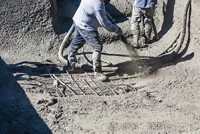Advertisement
Grab your lab coat. Let's get started
Welcome!
Welcome!
Create an account below to get 6 C&EN articles per month, receive newsletters and more - all free.
It seems this is your first time logging in online. Please enter the following information to continue.
As an ACS member you automatically get access to this site. All we need is few more details to create your reading experience.
Not you? Sign in with a different account.
Not you? Sign in with a different account.
ERROR 1
ERROR 1
ERROR 2
ERROR 2
ERROR 2
ERROR 2
ERROR 2
Password and Confirm password must match.
If you have an ACS member number, please enter it here so we can link this account to your membership. (optional)
ERROR 2
ACS values your privacy. By submitting your information, you are gaining access to C&EN and subscribing to our weekly newsletter. We use the information you provide to make your reading experience better, and we will never sell your data to third party members.
Business
Paints and Coatings
Consolidation among paint material makers brings opportunities as well as risks
by Marc S. Reisch
October 16, 2006
| A version of this story appeared in
Volume 84, Issue 42
COVER STORY
Paints and Coatings
Few people sit around watching paint dry, but enough people buy the stuff to make it a major market for the chemical industry. Polymers, emulsions, pigments, coalescents, and other paint ingredients are a showcase of the industry's invention and ingenuity. Paint material makers are consolidating, however, driven by the paint business' slow growth, complications wrought by growing environmental regulations, and difficulties in passing on increases in raw material and energy costs.
In some cases, the consolidators are combining acquired technologies with in-house skills to spur new growth. In other cases, raw material suppliers are adopting advances in areas other than paint as a way to boost both paint material innovation and profits.
In 2005, paint formulators worldwide sold $86 billion worth of architectural, product, and special-purpose coatings, according to a study of the market by Euromonitor International. The study, conducted for paint maker Akzo Nobel and published earlier this year, concludes that the global market has been growing at about 3% annually in dollar terms over the past four years. The pace of growth is likely to increase to more than 5% annually over the next 10 years, thanks to rapid growth in the Asia-Pacific region and Eastern Europe.
Because of the large number of ingredient makers and paint formulators scattered across the globe, the size of the global paint business is difficult to gauge, so estimates vary. Phillip G. Phillips, managing director of Chemark Consulting, sets the value of the market at just $72 billion. North America and Western Europe are mature, stable markets growing at about the same rate as the economy overall. But the fastest growing markets are in the rapidly industrializing countries of the Asia-Pacific region, where Phillips says paint sales are growing at about 14% annually.
Despite the growing value of paint sales, paint prices have not kept pace with consumer price indexes in North America and Western Europe. Phillips attributes the lag to the overcapacity that plagues both regions' paint industries. The resulting competition limits price increases and even forces some paint makers to fold. Phillips counted 2,000 North American paint makers in 1975, but he counts only about 900 today. In Western Europe, the story is much the same, with 2,700 paint makers declining to 1,000 today.
The tough competition also makes it difficult for paint makers to pass along increases in energy and raw material costs. Phillips blames paint makers and material suppliers for not doing enough to convince buyers that paint is a valuable commodity.
One way out of the price conundrum would seem to be controlling more of the value chain by manufacturing both paint raw materials and finished paint products. With a few exceptions, though, companies haven't pursued that business model. For instance, when paint raw material maker Rohm and Haas bought Morton International in 1999, it also acquired an automotive paint business. It recently sold that business to Nippon Paint for $230 million.
Akzo Nobel found that it could not leverage its coatings resins business and sold it in 2004 to New Zealand-based resins maker Nuplex Industries for $140 million. "Akzo could buy coatings resins from other makers comparable to what it made itself at about the same price," Phillips says.
Some paint material suppliers do also make coatings, but they succeed at it by operating the businesses in silos that do well on their own, Phillips says. Such is the case with BASF, which makes pigments and urethane systems, for instance, as well as formulated paint for automobiles and coil coatings. It is also the case for DuPont, which supplies paint makers with the widely used white pigment titanium dioxide and also formulates car paints.
More commonly, though, raw material suppliers have a hands-off attitude toward the finished paint business. Instead, they look to buy businesses that extend their reach and profit potential in paint materials.
In 2005, for example, Cytec Industries bought UCB's surface specialties business. The $1.8 billion purchase extended Cytec's geographical reach in Asia and gave the firm new positions in the fast-growing powder and radiation-curable coatings markets. The UCB businesses also included former Solutia and Hoechst coatings resins operations that UCB acquired in 2003.
Jean-Marc Durbuis, Cytec's global business director for powder coatings, says the combination of Cytec and UCB operations puts the firm's focus on higher growth paint technologies such as water-based alkyd and acrylic resins, polyurethane dispersions, and ultraviolet-light-curable resins. While the global paint market lumbers along at roughly 3% growth per year, the markets Cytec serves grow at 5-10% annually, Durbuis says.
In powder coatings, Cytec supplies the polyester and acrylic resins used to make heat-fusible paint. According to Durbuis, the company is linking this powder know-how with its expertise in ultraviolet-curable coatings to help formulators develop new markets for UV-curable powders and UV-curable polyurethane dispersions.

In a different kind of crossover project, Durbuis says his firm is working with coil coaters to eliminate emissions of the greenhouse gas carbon dioxide. In coil coating, large sheets of metal are typically painted with solvent-borne paints. The paint dries in an oven in which volatile organic compounds (VOCs) are captured and burned off. The metal sheets are then rolled into coils and sold to make dishwashers, refrigerators, and other appliances.
But because of pending environmental regulation in California and Germany, CO2 produced in the burning process must be reduced or eliminated. "Coil coatings could go to powder or radiation-curable coatings," Durbuis says.
Acquisitions have also helped Celanese enlarge its footprint in paint materials, first with the purchase of Clariant's emulsion polymers business in 2003 and then with the purchase of ICI's Vinamul unit in 2005. The Clariant deal made Celanese a leader in vinyl acetate ethylene emulsions (VAE) in Europe, says Helmut Plum, global business director for the firm's paints and coatings sector.
Celanese has already helped European customers formulate very low VOC coatings based on VAE, and Plum says an increasing amount of architectural coatings sold in Western Europe are virtually VOC-free. He says the Vinamul acquisition has further expanded the firm's VAE sales as it helps U.S. customers respond to a similar low-VOC push.
At Air Products & Chemicals, the merger and acquisition story is more complex. Its large emulsion polymers business, part of a joint venture with Wacker Chemie, is on the block to be sold. Yet the firm recently acquired Tomah Products, a producer of specialty surfactants, with an eye to expanding Tomah's cleaning and oil-field chemicals into the coatings industry.
Indeed, thanks to an earlier partnership with Tomah, Air Products has already transferred Tomah alcohol alkoxylate technology for cleaning products to the waterborne paints market. Laurie Marshall, marketing manager for coatings and adhesives, says the new Carbowet surfactants are for architectural paint formulations and replace alkylphenol ethoxylate wetting agents that are persistent in the environment and suspected of being endocrine disrupters.
The new additives are simple drop-in replacements for the alkylphenol ethoxylates in most cases, Marshall says. "They will also enable us to expand our presence in architectural coatings."
The combination of Carbide and Dow Chemical "has accelerated cross-platform learning," says Graves Clayton, North American coatings market manager. As a result, a Dow-developed opacifier used for paper is being adapted for coatings. Use of the Ucarhide opacifier will reduce the need for more expensive titanium dioxide, he says.
Like Celanese, Dow sees opportunities for VAE because of more stringent environment regulations. The firm has developed the first in a new line of ethylene-modified polymers that it claims have better performance properties than traditional VAEs. The new Evocar emulsion is resistant to water and blocking, such as when a painted door gets stuck to a painted frame. It is also an inherently low-VOC product that will meet California's demanding new 50-g/L requirements, Clayton says.
Although not due to an acquisition, Ciba Specialty Chemicals also transfers product developments from one platform to another. For instance, the firm often develops light stabilizers and antioxidants to improve the durability and weather resistance of plastics and then transfers them to the coatings business, says Colin C. Mackay, head of coating effects for Ciba. Another example is silver-ion-based bactericides developed for plastics but now being used in coatings, he says.
Ciba also develops photoinitiators used in radiation-curable coatings, and for this market, it is developing a new process, along with partners in a consortium, to instantly cure large three-dimensional objects such as entire car bodies. The consortium members have developed a plasma chamber filled with an inert gas such as helium or nitrogen, says technical manager Eugene V. Sitzmann.

A short microwave burst in the chamber creates a UV light that instantly cures coatings in every nook and cranny that the gas has penetrated. "It is like placing a car inside a light bulb," Mackay says. Even the most complex 3-D object can cure with minimum VOC emissions, he claims.
Rohm and Haas managers say their coatings raw material business is more often a source of new ideas for other business platforms. For instance, the firm's Ropaque styrene acrylic hollow spheres were developed to replace more expensive titanium dioxide in paint formulations. But now the firm has developed a market for the hollow spheres in personal care sunscreens under the SunSpheres name, says Luis Fernandez, business unit director for architectural and functional polymers.
Some firms are concentrating on slimmed down paint material portfolios. Eastman Chemical sold off its Lawter and McWhorter resins businesses in 2004 and now focuses on its traditional coatings additives, adhesion promoters, low-VOC solvents, and coalescent agents. "We look for ways to leverage internal technology to satisfy customer needs," says David C. Stump, general manager of the global coatings business.
An example is Eastman's development of Optifilm coalescents, introduced two years ago for use in low-VOC formulations that meet the new California requirements.
Whether they have reduced their heft, like Eastman, or enlarged their presence in the market, like Cytec, all the key players acknowledge that invention and ingenuity in developing raw materials is still the key to success.








Join the conversation
Contact the reporter
Submit a Letter to the Editor for publication
Engage with us on Twitter